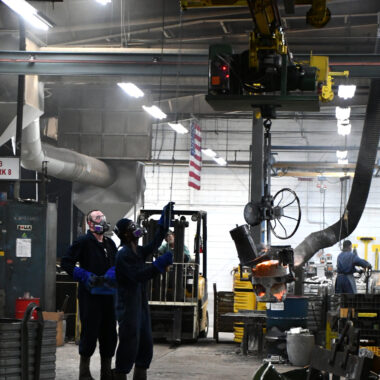Optimizing Efficiency: Unleash the Power of Aluminum Casting for Superior Products
Optimizing Efficiency: Unleash the Power of Aluminum Casting for Superior Products
Blog Article
Study the World of Light Weight Aluminum Spreading: Understanding the Various Approaches
Light weight aluminum casting is an essential process in the manufacturing industry, with various techniques employed to develop detailed and accurate parts. From the standard sand spreading method to the innovative die spreading procedure, each technique uses distinct advantages depending on the needs of the job.
Sand Casting Approach
Sand casting, a widely-used approach in light weight aluminum spreading procedures, entails developing molds made of compressed sand for putting liquified metal. When the mold is prepared, it is securely put in a flask and molten aluminum is poured into the tooth cavity.
After the metal has actually cooled and solidified, the sand mold and mildew is broken away to expose the light weight aluminum casting. Sand spreading permits for the production of intricate shapes and large parts that might be hard or costly to create utilizing various other techniques. It is also a lasting strategy as the sand can be reused and utilized numerous times, decreasing waste in the spreading process.
Permanent Mold And Mildew Technique

One significant benefit of the Irreversible Mold Strategy is the enhanced dimensional precision it supplies. The metal mold enables tighter tolerances and better details in the last light weight aluminum castings compared to sand spreading approaches. This precision makes it a preferred selection for applications where tight dimensional control is critical, such as in the aerospace and automotive markets.

Pass Away Casting Refine

Financial Investment Casting Method
Using an accuracy spreading approach, Financial investment Casting Technique includes producing elaborate aluminum parts by putting molten metal into a ceramic mold. This process, additionally recognized as lost-wax casting, begins with the creation of a wax pattern of the wanted part. This wax pattern is then covered with a ceramic material to form a covering. When the ceramic shell is set, it is warmed to eliminate the wax, leaving behind a hollow ceramic mold and mildew.
Investment spreading is generally used for producing parts in industries where elaborate styles and limited resistances are called for, such as aerospace, automotive, and medical devices. The adaptability and accuracy of the Financial investment Casting Strategy make it a beneficial strategy in the world of light weight aluminum spreading.
Lost Foam Casting Approach
Having checked out the detailed precision of Investment Casting Approach, the emphasis currently shifts to the cutting-edge approach of Lost Foam Casting in light weight aluminum element production. Lost Foam Casting, additionally known as evaporative pattern spreading, is a modern technique where a foam pattern of the preferred part is created and after that coated with a refractory product.
Among the primary advantages of Lost Foam Spreading is its capability to produce intricate forms with elaborate information, usually in a solitary piece without the demand for extra Full Report machining. This method is additionally understood for its high dimensional accuracy and smooth surface area finish. In Addition, Lost Foam Spreading is an economical process as it lowers the requirement for cores and permits the manufacturing of lightweight parts. In spite of its benefits, Lost Foam Casting calls for cautious control of the spreading process to prevent flaws and guarantee high quality components.
Conclusion
To conclude, light weight aluminum spreading provides a selection of methods such as sand spreading, irreversible mold and mildew method, pass away spreading, investment casting, and lost foam spreading. Each approach has link its very own advantages and applications, making aluminum casting a flexible and extensively made use of process in various industries. Comprehending the distinctions in between these approaches is essential in choosing the most appropriate spreading strategy for particular production demands.
Sand casting, a widely-used method in light weight aluminum spreading procedures, entails creating mold and mildews made of compressed sand for putting liquified steel. aluminum casting.The Irreversible Mold And Mildew Strategy, like sand spreading, is an additional widespread approach used in light weight aluminum spreading procedures, using unique benefits in terms of mold reusability and dimensional precision. The steel mold and mildew permits for tighter resistances and finer details in the final aluminum spreadings contrasted to sand spreading techniques. The two main types of die spreading are cool chamber pass away casting and hot chamber die spreading, each ideal for various types of aluminum alloys.In verdict, light weight aluminum spreading provides a variety of methods such as sand spreading, long-term mold technique, pass away spreading, investment casting, official statement and shed foam casting
Report this page